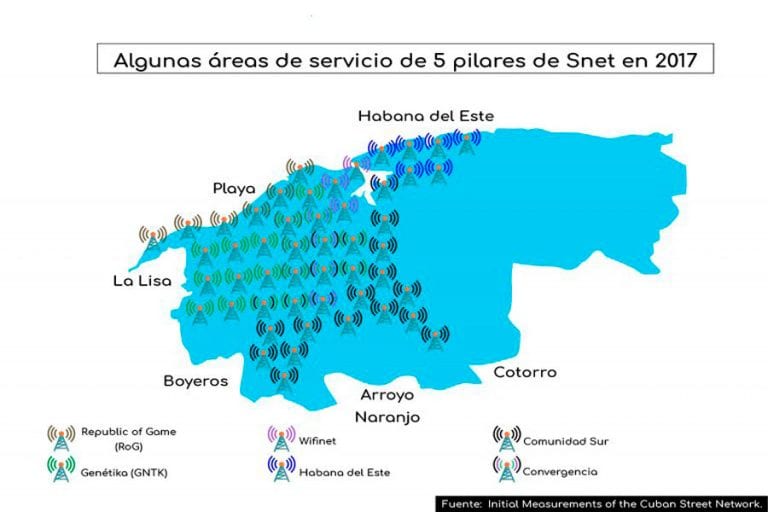New and Old Digital Communities Made in Cuba
New challenges for civilian networks
New digital communities made in Cuba are mobilizing to find solutions, but other legendary ones are fighting to survive.

HAVANA TIMES – While greater Internet access has encouraged the creation of solidarity groups which share information about how to deal with food shortages, SNET, Havana’s street network, is fighting to survive in the face of Cuba’s new internet regulations.
These examples just go to show both sides of the coin: the irrepressible advances of civilian Internet use on the Caribbean island and the reservations and misunderstandings it faces in a country that is coming late to the digital era.
Long before Cuba’s state telecommunications company ETECSA increased Internet access in 2013, making it available to citizens for the equivalent of $5 USD/ hour, young people in the capital were looking for ways to connect to the Internet, for recreational purposes mostly.
SNET (Street Network), also known as the Havana network, was programmed in 2011, although according to statements from some of its founders to the Cuban magazine Somos Jovenes, it started out before the turn of the new century.

Today, it brings over 20,000 users together with their computers, connected mostly by nanostations, wireless multipliers and network cables; and it set up information portals, blogs, forums, social networks, ad websites, as well as other services.
Last week, Cuba’s Ministry of Communications announced new regulations that now make it legal for Cuban citizens to import wireless routers and create private wifi-networks so that individuals can connect to the Internet.
These government measures impose control and organization of Cuba’s radio-electric space, and it could drive civilian efforts to informatize society.
However, the regulations didn’t come as good news for SNET users, as its infrastructure doesn’t meet most of the established requirements. On July 29th, when these regulations come into force, the popular network will no longer be protected by the legal limbo it used to enjoy and will become illegal instead.
A statement written up by general and technical organizers from certain associations on the Street Network (which is currently fragmented because of internal differences), urges the corresponding authorities to consider the possibility of granting a special license so that the network can continue to run.
Circulated by the pillars of the Republic of Gamers community and East Havana, the document reaches out so as to create a mutually beneficially relationship between this sector of civilian society and those who want to lead the country’s informatization process.
An online petition to collect 10,000 signatures has been going around SNET’s internal networks, so that they can then ask for the regulation to be amended before it becomes the law.
The national network could take advantage of platforms that SNET has already created and improve with services that are more innovative and promote a greater tech culture among Cuban society, the statement points out.
SNET is looking to come to an agreement where they emit the minimal amount of acceptable noise without taking apart its entire technological framework and expensive devices that were purchased as a combined effort.
If they do reach an agreement, the informatization process would be an unprecedented management development model in Cuba, becoming a lot more horizontal and collaborative.
SNET has not only been used to share information or play online, it has also been an opportunity for emerging small tech companies to develop and for many young people to start out in this sector.
At least this is the way Carlos Javier Acosta Miranda sees it, a young 18-year-old developer who thanks the network for almost everything he knows.
“I’ve been playing around with programming ever since I was 13 years old. That’s why I began studying at the Fernando Agua y Rico I.T Polytechnic University (in Central Havana), looking for a way to develop this vocation; but it didn’t really help me, the curriculum was really old,” he tells IPS Cuba.
Things changed when Netlab came about, this street network’s I.T. community.
“I could talk about what I liked there and about the things I couldn’t find at the I.T. University, it was my real school. It also gave me my first paid job.”
Carlos Javier forms part of the Cuban project “Tecnolike plus” and is one of the app developers for “Datos Cuba”, which was created to monitor data consumption and optimize use of mobile data packages which are still expensive in Cuba.
Donde hay? Where are there?
Almost a thousand people are connected to the Donde hay (Where are there) channel. Havana on social media network Telegram and in Whatsapp groups that share the same name, in order to facilitate everyday hunts for food or any other product in shortage at stores in the capital.
On their runabouts of the city, users (who are more connected ever since mobile data packages became available in the country) locate and post products that other users need, the place where they found them and how long the line is to buy them.
“My granddaughter installed the app for me today. It’s a great idea,” Yolanda writes in the group, a 74-year-old woman who is trying to figure out how to make the most of this initiative, with the help of its administrators.
Admins warn that “the channel [won’t be allowed] to become a political platform.” Its mission is simple, get around shortages with a system of alternative social organization. Shortages have led the Ministry of Interior Commerce to regulate the sale of certain products to ensure that it is more fairly accessible.
The channel has the same name and identity as the app by the government’s Cimex business group which promised to facilitate Cubans’ shopping, but the outcome fell short because of irregular supplies to the country’s retail points, where products run out in a matter of hours.
However, Donde hay? Villa Clara, a province in Cuba’s central region, 250 kms away from Havana, hasn’t been as popular.
“It’s an ingenious idea because it’s really become an odyssey to find the things you need every day. So, I don’t know if it works here. In Havana, people are more connected, here people buy mobile data packages to talk to their families, they aren’t always connected,” Ana Belkis Chirino, a local journalist in Santa Clara, tells IPS.
With less than 50 users, the dynamics of this Villa Clara channel differ greatly to the capital’s version, where there has historically been greater civic movements in the country. Many of the users who join, leave the group a few minutes later.
Using social media to form solidarity and collaborative networks so as to find solutions to specific everyday problems, or to promote civic mobilization, is becoming more and more frequent in Cuba, especially in times of crisis.
This resource really kicked off after the tornado that hit Havana on January 27th, when thousands of people mobilized spontaneously, and it was mostly on Facebook that different aid initiatives for those affected were managed; something which had been the government’s sole responsibility until then.






The Internet as received in Cuba is not the complete Internet received in the free countries. But despite that censorship, Diaz-Canel has expressed his concern about improved access to information for the people of Cuba. It was he who decreed that the media were not to discuss the Air Cubana 737-200 series disaster of May 18, 2018 which killed over 100 Cubans, – and it should be noted that that has been effective! Access to information is the enemy of communism and both Fidel Castro and ‘Che’ Guevara railed against it.
So, if I understand correctly, SNET is how street corner hubs in Havana could operate. I have long wondered about how these guys who wheeled their hubs/routers/gear around town to their locations did not get prosecuted. It was obvious from the clusters of people sitting in doorways and on the kerb, their faces illuminated by the screenglow of their phones, that people were connecting in non-official WiFi zones and I did too because it was cheap, although not so reliable. (Also, my cousin set up a ‘bistec sandwi’ business so supper was on tap!) People explained to me when I asked in a very vague way as obviously, being a gray area who knew who was listening. Donde Hay and its ilk is good up to a point in that its another way heirarchy of have and have nots is becoming more and more obvious in Cuba. Time and again I think of the saying Cubans have “We went into the Special Period together and we are coming out of it one by one”. It happens all over the world but somehow it feels very wrong in a Socialist country like Cuba.
Today the Web is the most important tool all over the World.
Is opening peoples mind like never before we all should have acces to Internet where we can express ourself without any limitation. We have to keep moving toward the new Era.
Facebook.com/hermesuniverse
It seems likely that SNET and MINCOM will work out regulations on cables and high-speed wireless links to allow SNET to survive and even improve performance. It would be even better if ETECSA could view SNET as collaborators in providing Internet access like Guifi community network in Spain. See: https://laredcubana.blogspot.com/2019/06/cubas-new-wifi-regulations-good-bad-or.html
The Internet is a great innovation. It is information at the touch of your fingers. The issue is discerning truth from falsehood, no different than any other means of communication with all it’s implicit and explicit manipulations.